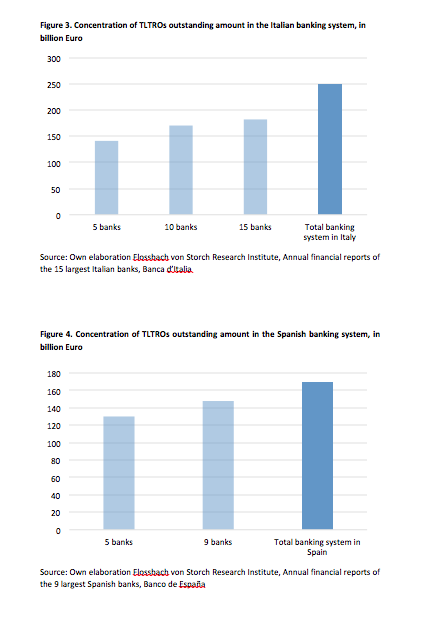The current 719 billion Euro batch of so-called targeted long-term refinancing operations (TLTROs), which maintain cheap refinancing conditions to commercial banks in the euro area, will mature between mid-2020 and early 2021. Were TLTROs to expire or become more expensive, the interest margins of banks – especially in Southern Europe (Italy and Spain) – would be negatively hit and the credit impulse would weaken. Hence, as said by Agnieszka Gehringer, senior analyst at Flossbach von Storchgiven the weakening economic momentum, the ECB has little choice but to extend the TLTROs.
The popularity of TLTROs II has a clear southern bias. Of the total outstanding amount, almost 35% was used by Italian and 24% by Spanish banks. The remaining 16% and 13% were used, respectively, by French and German banks (Figure below). The reason for this is that TLTROs in effect subsidize lending by weaker banks or banks in weaker economic environments. When banks extend credit they create deposits. And when customers move the deposits from weaker to stronger banks the weaker banks have to replace them by more expensive borrowing in the market. This forces them to increase their lending rates. TLTROs represent a much cheaper alternative. Thus, with TLTROs the ECB can subsidize lending rates by weaker banks or banks in weaker regions. The intensive use of TLTROs II in Italy and Spain is reflected in the large liabilities of the central banks of these countries within the Target2 interbank payment system (EUR 478 billion Euro for Italy and EUR 402 billion Euro for Spain in January 2019).

Moreover, there is a relatively high concentration of TLTROs in both the Italian and Spanish banking system. Of the total 250 billion Euro of TLTRO borrowing taken by Italian banks, almost 57% are held by five largest banks (Figure below). In Spain, the concentration is even higher, as around 75% of TLTROs in the Spanish banking system are with five largest banks (Figure below). This could lead the ECB to conclude that TLTROs are of systemic importance.

How not to throw out the baby with the bathwater?
In the current framework, TLTROs are subject to the paradox which forces the ECB to use an unconventional instrument even in good economic times. Only by relaunching (T)LTROs under conditions at least as good as under the current framework, the interest margins of banks – especially in Southern Europe (Italy and Spain) – would not be negatively affected and thus credit impulse would not be squeezed.
The current slowdown in economic activity and the core inflation rate of 0.96% moving away from the ECB’s goal should provide enough background for the ECB to justify a relaunch (T)LTROs. But this leaves the paradox alive in the future. To counteract this, the ECB may be inclined to introduce a more decisive innovation. Making TLTROs a permanent facility would indeed end the paradox, as the ECB would avoid having to justify the measure any more. To compensate the critics, the facility could have a shorter maturity than the current four years and be subject to a floating interest rate tracking the ECB’s main refinancing rate. This would leave the ECB at least a formal leeway, but would by no means imply an obligation to raise rates.
The time factor
Although the last tranche of TLTROs II will mature in March 2021, the details on the TLTRO-relaunch could already be announced at the next ECB meeting on 7th March or at latest in June. The reason for this is that under Basel III rules, funds with a maturity less than 12 months cannot be used to determine the so called net stable funding ratio (NSFR), which ensures that banks avoid excessive liquidity mismatches due to maturity transformation (lending long-term and funding themselves short-term).The NSFR requires banks to have enough funding with a residual maturity of more than one year. Since almost 380 billion Euro will mature in June 2020, it should be in the ECB’s interest to ensure funding continuity at favorable funding cost
NSFR replaced at the end of 2016 the Structural Liquidity Ratio, which is calculated as the ratio between liabilities and assets with maturity above one year. Each bank sets the internal limit for this liquidity ratio. For instance, the Italian Unicredit sets the internal limit at 90%, meaning that at least 90% of the assets with a maturity above one year must be financed with liabilities with maturity above one year.





